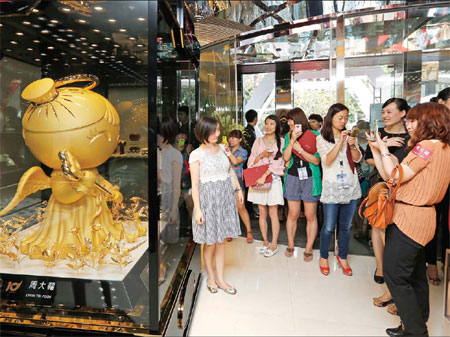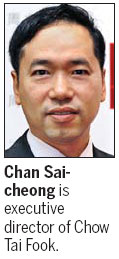|
 |
|
Chow Tai Fook unveils a 1.2-meter-tall golden "serene baby" - part of its baby family collection - at its flagship store in Chongqing on Sept 15, 2012. [Photo/China Daily] |
Hong Kong retailer expects big surge in mainland jewelry sales, plans expansion
Hong Kong-based Chow Tai Fook Jewelry Group Ltd, the world's largest jewelry retailer by market value, is adding more stores on the Chinese mainland to cater to the growing demand for gold and jewelry.
Chan Sai-cheong, executive director of Chow Tai Fook Jewelry Group Ltd, says the jewelry chain, whose mainland business is headquartered in Shenzhen, Guangdong province, will set up another 230 retail points of sale and stores on the Chinese mainland in its 2013 fiscal year and invest 5 billion yuan ($793 million, 620 million euros) to build an industrial park in Wuhan, Hubei province.

By the end of June, which also was the end of its fiscal 2012, the company had 1,674 outlets, with more than 90 percent of them on the mainland.
The company is planning to invest more than 200 million yuan to upgrade its mainland headquarters in Shenzhen and build a complete supply chain.
More Chinese residents have become wealthier as the per capita disposable income has risen significantly, resulting in an increased demand for luxury goods such as jewelry, champagne, bags and vehicles.
Chow Tai Fook opened its first retail store in Beijing in 1998, and since then has pursued an active expansion policy.
According to a report released by US business consulting firm Frost & Sullivan in June 2012, Chow Tai Fook's market share continued to increase in the Chinese mainland as well as in Hong Kong and Macao, growing from 12.6 percent in 2010 to 14.4 percent in 2011 in the Chinese mainland, and from 20.1 to 21.4 percent in Hong Kong and Macao during the same period.
In its 2012 fiscal year, the company's sales revenue hit HK$56.57 billion ($7.3 billion, 5.64 billion euros) representing a surge of 61.4 percent over the same period of its 2011 fiscal year. Gross profit increased by 65.7 percent, from HK$9.93 billion in fiscal 2011 to HK$16.45 billion in fiscal 2012, while the gross profit margin increased by 29.1 percent.
Chan says the growth in fiscal 2012 was mainly fueled by the expansion of Chow Tai Fook's point of sale network and strong same-store sales growth, which underpinned the company's marketing strategies and continued business expansion in the Chinese mainland from previous years.
Chow Tai Fook's Wuhan jewelry park is spread over 40 hectares and will soon become its largest integrated production base catering to the needs of the fast-growing jewelry retail business on the mainland.
The park has a production plant, a national distribution center, a sales exhibition and visitor center, craft-training center and other support facilities. The whole project will be completed in 2016.
"Developing the jewelry park in Wuhan will further centralize and standardize Chow Tai Fook's production monitoring process, and further improve the vertically integrated business model to provide a wider range of jewelry products to the market," Chan says. "We are planning to employ 5,000 people at this park and create output value of 15 billion yuan every year."
Chow Tai Fook currently operates nine jewelry factories and three diamond-cutting factories, and has more than 29,600 employees throughout the world, mainly in China, Singapore, Malaysia and South Africa. The company added 254 points of sale and stores in China in its 2012 fiscal year.
The company's average jewelry sales has reached 1 million units per month on the Chinese mainland, and it is now working with the Hong Kong Productivity Council to develop a large-scale marking and logistics system to further improve efficiency and reduce human errors. The system will cost 20 million yuan and will be used in a new national distribution center at the company's Wuhan park.
The company is also building a new headquarters in Shenzhen for its operations on the mainland. The construction was started in 2011 and is expected to be operational by the end of 2013.
Chow Tai Fook wants these two projects to form a complete business value chain from overall resources development to production and operations.
In 2011, the average annual urban disposable income in China rose by 14 percent to about 21,810 yuan, according to the National Bureau of Statistics. Chan says even though per capita jewelry purchases in China still lag behind developed nations, the growing purchasing power will build "a solid foundation for fast market growth in the future".
Chan believes that more Chinese are putting their money on gold jewelry, gold coin and bullion investments.
"People have already experienced the fallout caused by the second round of quantitative easing (QE2), as concerns are rising that the launch of a QE3 by the US may push goods prices higher once again, as buying gold to a certain extent is an adequate measure to protect the value of their assets," Chan says.
"From my point of view, gold prices may rise by 10 percent a troy ounce this year."
He says many Chinese have already realized this and stopped buying large amount of foreign currencies such as euros or the US dollars. The Chinese government also focuses on boosting domestic demand to maintain a healthy economic environment amid a slowdown in exports and foreign direct investment.
"Therefore, the domestic market could allow for even broader development in the future. We are aiming to set up 2,000 retail points of sale and stores in Asia by 2014 and doubling our revenue in three years," Chan says.
Traditionally, Chinese people have always been fond of jewelry, especially gold and diamond jewelry. Many consumers buy gold bars, coins, rings, necklaces and bracelets when gold prices are high because they believe prices will rise again during certain periods.
"Once the jewelry market starts booming, it is easy for it to become a consumption trend," says David Wong, assistant general manager of Chow Tai Fook's regional operation center in western China. "The increasing awareness for buying various jewelry is also a part of the Chinese culture."
Wong says gold, diamond, platinum or gemstone jewelry are popular gifts for events such as engagements, festivals, weddings, baby showers and birthdays.
In 2011, domestic jewelry companies achieved sales of 183.7 billion yuan, with an annual growth of 42.1 percent, according to the National Bureau of Statistics. The growth rate is twice as high as that of the total retail sales of other consumer goods. The figure for the latter was 17.1 percent last year.
"Over the next three years, inlaid jewelry such as diamond, ruby and sapphire rings and necklaces will play a major role in the China market, as people want to diversify their investment categories and develop newer tastes for gemstones," Chan says.
zhongnan@chinadaily.com.cn
